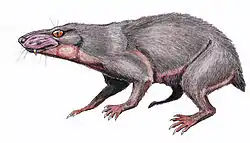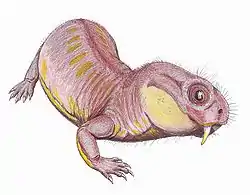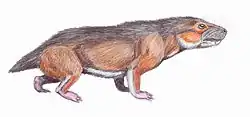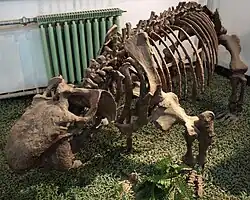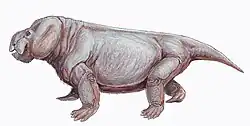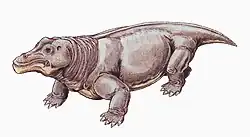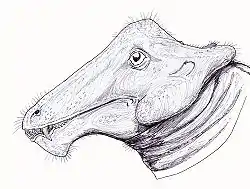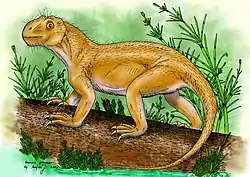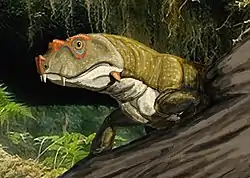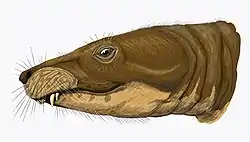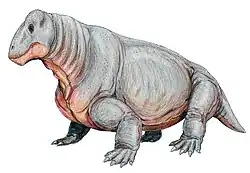Anexo:Terápsidos
Esta lista de terápsidos es un intento de crear un listado comprensible de todos los géneros incluidos en este grupo, excluye los mamíferos y los nombres vernáculos. La lista incluye todos los géneros aceptados por la comunidad científica, pero también aquellos que hasta el momento se han considerado inválidos, dudosos (nomen dubium), o no se han publicado formalmente (nomen nudum), también como los sinónimos o nombres más aceptados, y géneros que dejaron de ser considerados terápsidos.
La lista contiene hasta el momento 514 nombres genéricos.
Convenciones de nombres y terminología
La convención de nombres y terminología siguen el Código Internacional de Nomenclatura Zoológica (CINZ). Los nombres técnicos utilizados comprenden:
- Sinónimo más moderno: Es un nombre que describe el mismo taxón, como un nombre publicado previamente. Si dos o más géneros están formalmente designados y posteriormente son asignados a un mismo género, el primero publicado (en orden cronológico) es el sinónimo más antiguo, y todas las otras denominaciones son sinónimos más modernos.
- Nomen nudum (es el latín de «nombre desnudo»): Es un nombre que se ha publicado, pero no ha sido formalmente reconocido por el (CINZ).
- Nomen oblitum (es el latín de «nombre olvidado»): Es un nombre que no se ha utilizado en los últimos cincuenta años por la comunidad científica luego de ser propuesto originalmente.
- Nombre utilizado: Un nombre que está formalmente publicado pero que ya ha sido asignado a otro taxón. Este segundo nombre es inválido (como todos los usos subsecuentes) y el nombre debe ser reemplazado.
- Nomen dubium (es el latín para «nombre dudoso»): Es un nombre que describe un fósil en ausencia de un rasgo distintivo que lo defina. Como esto puede ser una designación subjetiva y controversial, este término no se usa en esta lista.
Listado
|
| ||||||||||||||||||||||||||||||||||||||||||||||||||||||||||||||||||||||||||||||||||||||||||||||||||||||||||||||||||||||||||||||||||||||||||||||||||||||||||||||||||||||||||||||||||||||||||||||||||||||||||||||||||||||||||||||||||||||||||||||||||||||||||||||||||||||||||||||||||||||||||||||||||||||||||||||||||||||||||||||||||||||||||||||||||||||||||||||||||||||||||||||||||||||||||||||||||||||||||||||||||||||||||||||||||||||||||||||||||||||||||||||||||||||||||||||||||||||||||||||||||||||||||||||||||||||||||||||||||||||||||||||||||||||||||||||||||||||||||||||||||||||||||||||||||||||||||||||||||||||||||||||||||||||||||||||||||||||||||||||||||||||||||||||||||||||||||||||||||||||||||||||||||||||||||||||||||||||||||||||||||||||||||||||||||||||||||||||||||||||||||||||||||||||||||||||||||||||||||||||||||||||||||||||||||||||||||||||||||||||||||||||||||||||||||||||||||||||||||||||||||||||||||||||||||||||||||||||||||||||||||||||||||||||||||||||||||||||||||||||||||||||||||||||||||||||||||||||||||||||
Véase también
Referencias
- Battail, B. & Surkov, M. V. Mammal-like reptiles from Rusia. In Benton, M. J.; Shishkin, M. A.; Unwin, D. M.; Kurochkin, E. N. The Age of Dinosaurs in Rusia and Mongolia. Cambridge University Press, 2001. 672 p.
- Carroll, R. L. Vertebrate Paleontology and Evolution. W. H Freeman Company, 1988.
- Lucas, S. G. Global Permian tetrapod biostratigraphy and biochronology. In Lucas, S. G.; Cassinis, G. & Schneider, J. W. (eds.). Non-marine permian biostratigraphy and biochronology. Geological Society, 2006. 344 p.
- Ivakhnenko, M. F. 2008. The first whaitsiid (Therocephalia, Theromorpha) from the terminal Permian of Eastern Europe. Paleontological Journal 42 (4): 409-413.
- Lucas, S. G. Chinese Fossil Vertebrates. Columbia University Press, New York, 2001.
- Modesto, S. P. & Rybcynski, N. The amniote faunas of the Rusian Permian: implications for Late Permian terrestrial vertebrate biogeography. In Benton, M. J.; Shishkin, M. A.; Unwin, D. M.; Kurochkin, E. N. The Age of Dinosaurs in Rusia and Mongolia. Cambridge University Press, 2001. 672 p.
- Reisz, R. R. & Dilkes, D. W. 1992. The taxonomic position of Anningia megalops, a small amniote from the Permian of Sudáfrica. Canadian Journal of Earth Science 29 (7): 1605–1608. Abstract
- Angielczyk, K. D. 2004. Phylogenetic evidence for and implications of a dual origin of propaliny in anomodont therapsids (Sinapsida). Paleobiology 30 (2): 268–296.
- Rubidge, B. S. 1994. Australosyodon, the first primitive anteosaurid dinocephalian from the Pérmico Medio of Gondwana. Paleontology 37 (3): 579-594.
- Reisz, R. R. & Heaton, M. J. 1982. Bayloria morei Olson 1941 identified as an immature specimen of the Permian reptile Captorhinus aguti (Cope, 1882)'. Canadian Journal of Earth Sciences 19 (6): 1232–1234. Abstract
- Gao, K.; Fox, R.C.; Zhou, C.-F.; Li, D.-Q. (2010). «A new nonmammalian eucynodont (Sinapsida, Therapsida) from the Triassic of northern Gansu Province, China, and its biostratigraphic and biogeographic implications». American Museum novitates 3685: 24p.
- Kemp, T. S. The Origin & Evolution of Mammals. Oxford University Press, 2005.
- Tverdokhlebov, V. P.; Tverdokhlebova, G. I.; Surkov, M. v.; Minikh, A. V. & Benton, M. J. 2005. Pérmico Medio vertebrates and their sedimentological context in the South Urals, Rusia. Earth-Science Reviews 69: 27-77.
- Watabe, M.; Tsubamoto, T. & Tsogtbaatar, K. 2007. A new tritylodontid Sinapsid from Mongolia. Acta Paleontologica Polonica 52 (2): 263–274.
- Li, J. 2000. The most primitive lower tetrapod fauna in China. Science in China Series D: Earth Sciences 44 (1): 47-51.
- Sues, H. -D. & Olsen, P. E. 1990. Triassic vertebrates of Gondwanan aspect from the Richmond basin of Virginia. Science 249: 1020-1022.
- Kenneth D. Angielczyk & Bruce S. Rubidge (2012): Skeletal morphology, phylogenetic relationships and stratigraphic range of Eosimops newtoni Broom, 1921, a pylaecephalid dicynodont (Therapsida, Anomodontia) from the Middle Permian of South Africa, Journal of Systematic Palaeontology, DOI:10.1080/14772019.2011.623723
- Bruner, J. C. 1991. A catalogue of Type Specimens of Fossil Vertebrates in the Field Museum of Natural History. Classes Amphibia, Reptilia, Aves and ichnites. Geology 22: 1-68.
- Bonaparte, J. F.; Martinelli, A. G. & Schultz, C. L. 2005. New information on Brasilodon and Brasilitherium (Cynodontia, Probainognathia) from the Triásico Tardío of southern Brasil. Revista Brasileira de Paleontologia 8 (1) 25-46.
- Rubidge, B. S. & Sidor, C. A. 2002. On the cranial morphology of the basal therapsids Burnetia and Proburnetia (Therapsida: Burnetiidae). Journal of Vertebrate Paleontology 22 (2): 257-267.
- Abdala, F. & Ribeiro, A. M. 2000. A new therioherpetid cynodont from the Santa Maria Formation (middle Triásico Tardío), southern Brasil. Geodiversitas 22 (4 : 589-596.
- C. F. Kammerer and K. D. Angielczyk. 2009. A proposed higher taxonomy of anomodont therapsids. Zootaxa 2018:1-24.
- Tverdokhlebov, V. P.; Tverdokhlebova, G. I.; Surkov, M. V. & Benton, M. J. 2002. Tetrapod localities from the Triassic of the SE of European Rusia. Earth-Science Reviews 60: 1-66.
- Abdala, F. Redescripción del cráneo y reconsideración de la Válidoez de Cynognathus minor (Eucynodontia, Cynognathidae) del Triásico Inferior del Mendoza. Ameghiniana 33 (2): 115-126.
- Kammerer, C. F.; Flynn, J. J.; Ranivoharimanana, L. & Wyss, A. R. 2008. New material of Menadon besairiei (Cynodontia, Traversodontidae) from the Triassic of Madagascar. Journal of Vertebrate Paleontology 28 (2): 445-462.
- Prasad, G. V. R. Sedimentary Basins and Fossil Records. In Singhvi, A. K.; Bhattacharya, A. & Guha, S. (eds.). Glimpses of Geo-Science Research in India: Indian Report to IUGS 2002-2008. Indian National Science Academy, 2008.
- Angielczyk, K.D.; Sidor, C.A.; Nesbitt, S.J.; Smith, R.M.H.; Tsuji, L.A. (2009). «Taxonomic Revision and New Observations on the Postcranial Skeleton, Biogeography, and Biostratigraphy of the Dicynodont Genus Dicynodontoides, the Senior Subjective Sinónimo of Kingoria (Therapsida, Anomodontia)». Journal of Vertebrate Paleontology 29 (4): 1174-1187. doi:10.1671/039.029.0427.
- Schultz, C. L. & Langer, M. C. Tetrápodes Triássicos do Rio Grande do Sul. Interciência, 2007.
- Sidor, C. A. & Hancox, P. J. 2006. Elliotherium kersteni, a new tritheledontid from the Lower Elliot Formation (Upper Triassic) of South Africa. Journal of Paleontology 80 (2): 333-342.
- Cox, C. B. 1964. On the palate, dentition, and classification of the fossil reptile Endothiodon and related genera. American Museum Novitates 2171: 1-20.
- Rubidge, B. S.; King, G. M. & Hancox, P. J. 1994. The postcranial skeleton of the earliest dicynodont Sinapsid Eodicyninodon from the Middle Permian of South Africa. Paleontology 37 (2): 397-408.
- Dixon, D.; Cox, B.; Savage, R. J. G. & Gardine, B. (eds.). The Macmillan Illustrated Encyclopedia of Dinosaurs and Prehistoric Animals. Macmillan Publishing Company, 1988.
- Abdala, F. & Malabarba, M. C. 2007. Enamel microstructure in Exaeretodon, a Triásico Tardío South American traversodontid (Therapsida: Cynodontia). Revista Brasileira de Paleontologia 10 (2): 71-78.
- Godefroit, P. 1999. New traversodontid teeth from the Upper Triassic of Habay-la-Vieille (southern Belgium). Paläontologische Zietschdrift 73 (3/4): 385-394.
- Colbert, E. H. & Kitching, J. W. 1977. Triassic cynodont reptiles from Antarctica. American Museum Novitates 2611: 1-30.
- Botha J. & Smith, R. H. M. 2007. Lystrosaurus species composition across the Permo–Triassic boundary in the Karoo Basin of Sudáfrica. Lethaia 40: 125–137.
- Kurkin, A. A. 2006. A new dicynodont from the Middle Permian of Tatarstan. Paleontological Journal 50 (4): 434-437.
- Liu, J. 2007. The taxonomy of the traversodontid cynodonts Exaeretodon and Ischignathus. Revista Brasileira de Paleontologia 10 (2): 133-136.
- Modesto, S. P.; Rubidge, B. S. & Welman, J. 2003. Erratum: A replacement name for Lanthanocephalus Modesto, Rubidge and Welman 2002, not Lanthanocephalus Williams and Starmer 2000. Canadian Journal of Earth Sciences 39 (12): 1755–1765.
- Sidor, C. A. & Welman, J. 2003. A second specimen of Lemurosaurus pricei (Therapsida: Burnetiamorpha). Journal of Vertebrate Paleontology 23 (3): 631-642.
- Sidor, C. A.; Hopson, J. A. & Keyser, A. W. 2004. A new burnetiamorph therapsid from the teekloof formation, Permian, of South Africa. Journal of Vertebrate Paleontology 24 (4): 938–950.
- Sidor, C. A. & Smith, R. M. H. 2007. A second burnetiamorph therapsid from the Permian of Teekloof Formation of Sudáfrica and its associated fauna. Journal of Vertebrate Paleontology 27 (2): 420-430.
- Sidor, C. A. 2003. The naris and palate of Lycaenodon longiceps (Therapsida: Biarmosuchia), with comments on their early evolution in the Therapsida. Journal of Paleontology 77 (5): 977-984.
- Liu, J.; Soares, M. B. & Reichel, M. 2008. Massetognathus (Cynodontia, Traversodontidae) from the Santa Maria Formation of Brasil. Revista Brasileira de Paleontologia 11 (1): 27-36.
- Hammer, W. C. Fossils, Vertebrates. In Riffenburgh, B. (ed.). Encyclopedia of the Antarctic. CRC Press, 2007.
- Hopson, J. A. & Sues, H.-D. 2006. A traversodont cynodont from the Triásico Medio of Baden-Württemberg (Germany). Palaontologische Zietschrift 80 (4): 124-129.
- Mazin, J. M. & King, G. M. 1991. The first dicynodont from the Late Permian of Malagasy. Paleontology 34 (4): 837-842.
- Rubidge, B. S.; Sidor, C. A. & Modesto, S. P. 2006. A new burnetiamorph (Therapsida: Burnetiamorpha) from the Pérmico Medio of Sudáfrica. Journal of Paleontology 80 (4): 740-749.
- Smith, R. M.; Rubidge, B. S. & Sidor, C. A. 2006. A new burnetiid (Therapsida: Biarmosuchia) from the Pérmico Medio of Sudáfrica and its biogeographic implications. Journal of Vertebrate Paleontology 26 (2): 331-343.
- Sues, H.- D.; Olsen, P. E. & Carter, J. G. 1999. A Triásico Tardío Traversodont Cynodont from the Newark Supergroup of North Carolina. Journal of Vertebrate Paleontology 19 (2): 351-354.
- Sidor, C. A. & Smith, R. M. 2004. A new galesaurid (Therapsida: Cynodontia) from the Triásico Inferior of Sudáfrica. Paleontology 47 (3): 535-556.
- Kenneth D. Angielczyk; Bruce S. Rubidge (2010). «A new pylaecephalid dicynodont (Therapsida, Anomodontia) from the Tapinocephalus Assemblage Zone, Karoo Basin, Middle Permian of South Africa». Journal of Vertebrate Paleontology 30 (5): 1396-1409. doi:10.1080/02724634.2010.501447.
- Bonaparte, J.F.; Soares, M.B.; Schultz, C.L. (2006). «A new non-mammalian cynodont from the Triásico Medio of southern Brasil and its implications for the ancestry of mammals». New Mexico Museum of Natural History and Science Bulletin 45: 599-607.
- Reichel, M.; Schultz, C. L. & Soares, M. B. 2009. A new traversodontid cynodont (Therapsida, Eucynodontia) from the Triásico Medio Santa Maria Formation of Rio Grande do Sul, Brasil. Palaeontology 52 (1): 229–250.
- Liu, J.; Rubidge, B; Li, J. (2009). «New basal Sinapsid supports Laurasian origin for therapsids». Acta Palaeontologica Polonica 54 (3): 393-400. doi:10.4202/app.2008.0071.
- Roychodhury, T. 1970. Two new dicynodonts from the Triassic Yerrapalli Formation of central India. Paleontology 13 (1): 132-144.
- Reisz, R. R. & Berman, D. S. 1985. Scoliomus puercensis Williston and Case, 1913, identified as a junior synonym of Sphenacodon ferox Marsh (Reptilia, Pelycosauria)'. Canadian Journal of Earth Sciences 22(8): 1236–1239. Abstract
- Langston, w. 1965. Oedalops campi (Reptilia: Pelycosauria) new genus and species from the Pérmico Inferior of New Mexico and the family Eothryrididae. Bulletim of Texas Memorial Museum 9: 1-45.
- Conrad, J.; and Sidor, C. A. (2001). «Re−evaluation of Tetraceratops insignis (Sinapsida: Sphenacodontia)». Journal of Vertebrate Paleontology 21: 42A.
- Oliveira, T.V.; Soares, M.B.; Schultz, C.L. (2010). «Trucidocynodon riograndensis gen. nov. et sp. nov. (Eucynodontia), a new cynodont from the Brasilian Upper Triassic (Santa Maria Formation)». Zootaxa 2382: 1-71.
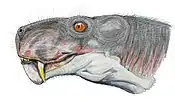






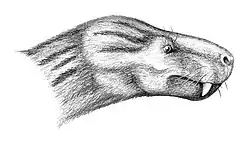
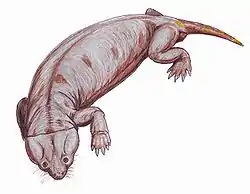
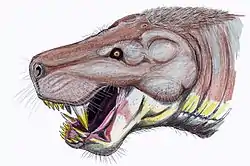
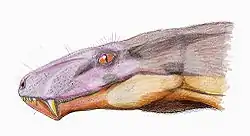

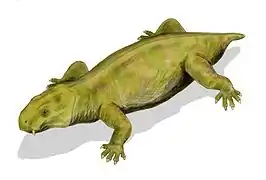

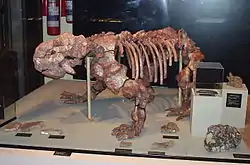
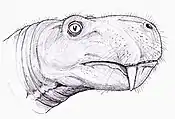
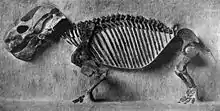

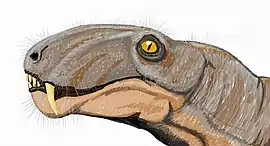

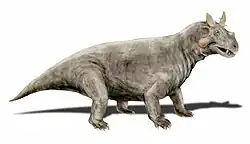
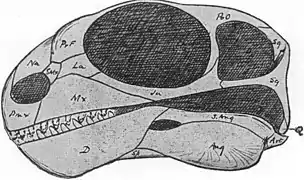



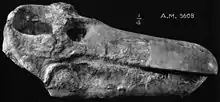
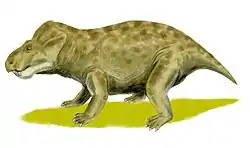
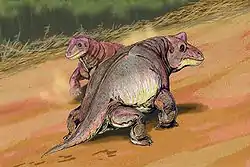
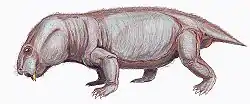
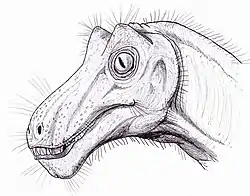

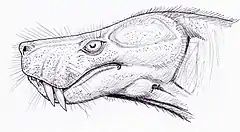
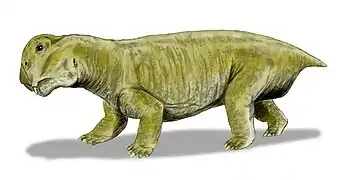
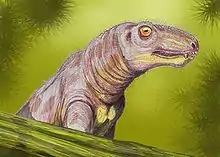
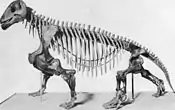

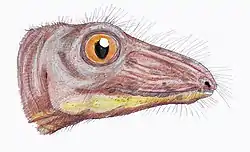
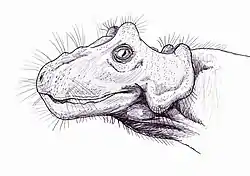
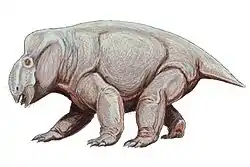

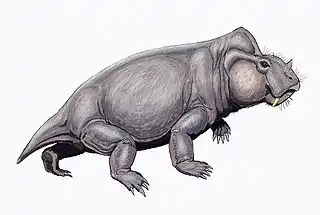
.jpg.webp)
